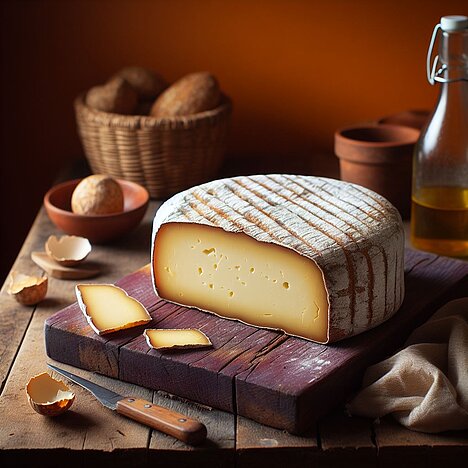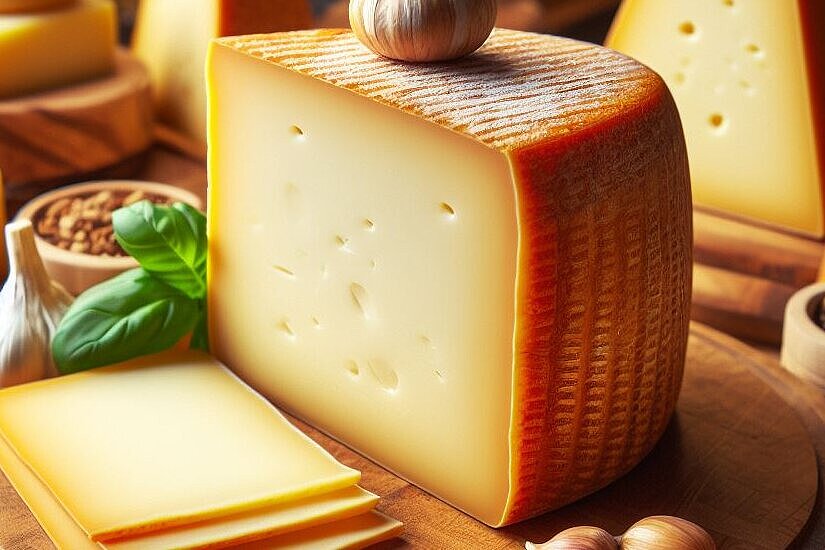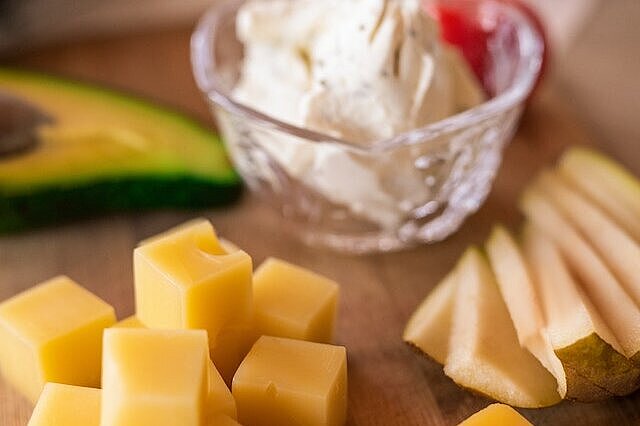Comté

But is Comté also suitable for dogs? Can you give your four-legged friend this delicious cheese as a snack or reward? What are the advantages and disadvantages of Comté for dogs? In this article, you will find out everything you need to know about Comté in relation to dogs.
What is Comté?
Comté is usually produced in small cheese dairies (fruitière in French) run by cooperatives. Around 450 liters of milk are needed to produce a 40 kilogram wheel of Comté cheese. The milk is heated to 33 °C in copper vats and rennet is added. This separates the curd mass and whey. After the milk has curdled, the curd is broken into pieces the size of a grain of rice and heated to 53 degrees while being carefully stirred. Around 30 minutes later, the mass is poured into a press mold, pressed for 24 hours and turned at regular intervals. As soon as the mass has drained, the cheese is placed in the warming or pre-maturing cellar for interim storage. The cheese is then stored for at least four months in maturing cellars, where it is regularly turned and rubbed with red smear bacteria (mainly Brevibacterium linens) in a salt solution. Maturing times of up to 24 months are typical. More rarely, cheeses matured for three or four years are also offered.
The cheese wheel is cylindrical with a diameter of 65-70 cm, a height of 8-13 cm, a slightly curved edge and a weight of between 30 and 48 kg with a fat content (based on dry matter) of 45-48 %. Each loaf that leaves the maturing cellar is judged by a jury of experts. A maximum of 20 points can be achieved. Only cheeses with at least 15 points receive the green "COMTÉ Extra" label. With 12 to 14 points, they receive a brown band. If fewer points are achieved, the cheese may not be sold as Comté and is marked with a grid in the rind.
What are the benefits of Comté for dogs?
Comté can have several benefits for dogs if it is fed in moderation. For one, Comté is a good source of calcium, which is important for strong bones and teeth. Comté also contains proteins that are useful for muscle building and regeneration. Comté also provides vitamins such as A, B2 and B12, which are important for vision, metabolism and blood formation.
Comté can also serve as a tasty reward or motivation for your dog, for example during training or grooming. Many dogs love the taste and smell of cheese and enjoy a small piece of Comté as a snack between meals. Comté can also help to strengthen the bond between you and your dog if you feed him the cheese from your hand or share it with him.
What are the disadvantages of Comté for dogs?
Comté also has some disadvantages for dogs that you should be aware of before giving it to your dog. Firstly, Comté is very high in fat and calories, which can lead to obesity and health problems such as diabetes or cardiovascular disease if it is fed too often or in too large quantities. Comté also contains a lot of lactose, which is not well tolerated by some dogs and can lead to digestive problems such as diarrhea, flatulence or vomiting. You should therefore always pay attention to how your dog reacts to Comté and stop feeding it if necessary.
Another disadvantage of Comté is that it contains a lot of salt, which can be harmful to dogs. Too much salt can increase blood pressure and put a strain on the kidneys. In addition, salt can lead to increased thirst, which in turn can lead to water intoxication if the dog drinks too much. You should therefore always provide your dog with fresh water when you give him Comté.
Finally, Comté can also trigger allergies or intolerances, which can manifest themselves in skin rashes, itching, hair loss or breathing difficulties. If you suspect that your dog is allergic or intolerant to Comté, you should take him to the vet immediately and stop feeding him.
Comté is a delicious cheese from France that can have some benefits for dogs, but also some disadvantages. You can give your dog a small piece of Comté from time to time as a snack or reward if he tolerates it well and has no health problems. However, you should always make sure that you don't give him too much Comté or too often, otherwise he may become overweight, develop digestive problems or other ailments. You should also always provide fresh water and be aware of any allergies or intolerances.
Comté is therefore not a must for dogs, but it is not taboo either. If you want to make your dog happy, you can treat him to a piece of Comté every now and then, but always in moderation and with caution.
If you notice any signs of hypersensitivity or poisoning in your dog, you should see your vet immediately. We are not a substitute for a vet, but we try to be as accurate as possible. Every dog reacts differently and we recommend you get a second opinion or consult your vet if in doubt.
Stay healthy and take good care of your four-legged friend!😊
Similar to Comté
Gruyère is a hard cheese made from raw cow's milk. It comes from the canton of Fribourg in Switzerland and is named after the town of Gruyères. It has had a protected designation of origin (PDO)...
Emmental consists mainly of cow's milk, which is pasteurized and mixed with rennet and lactic acid bacteria. The cheese then matures for several months in cool cellars, where it develops its typical...
Beaufort is a hard cheese made from raw cow's milk. It comes from the east of the department of Savoie and two neighboring municipalities in the department of Haute-Savoie in the French Alps. The...
Appenzeller cheese is a semi-hard cheese (or semi-hard cheese) made from raw milk. It comes from the Appenzell region in north-eastern Switzerland, where it has been produced according to...



